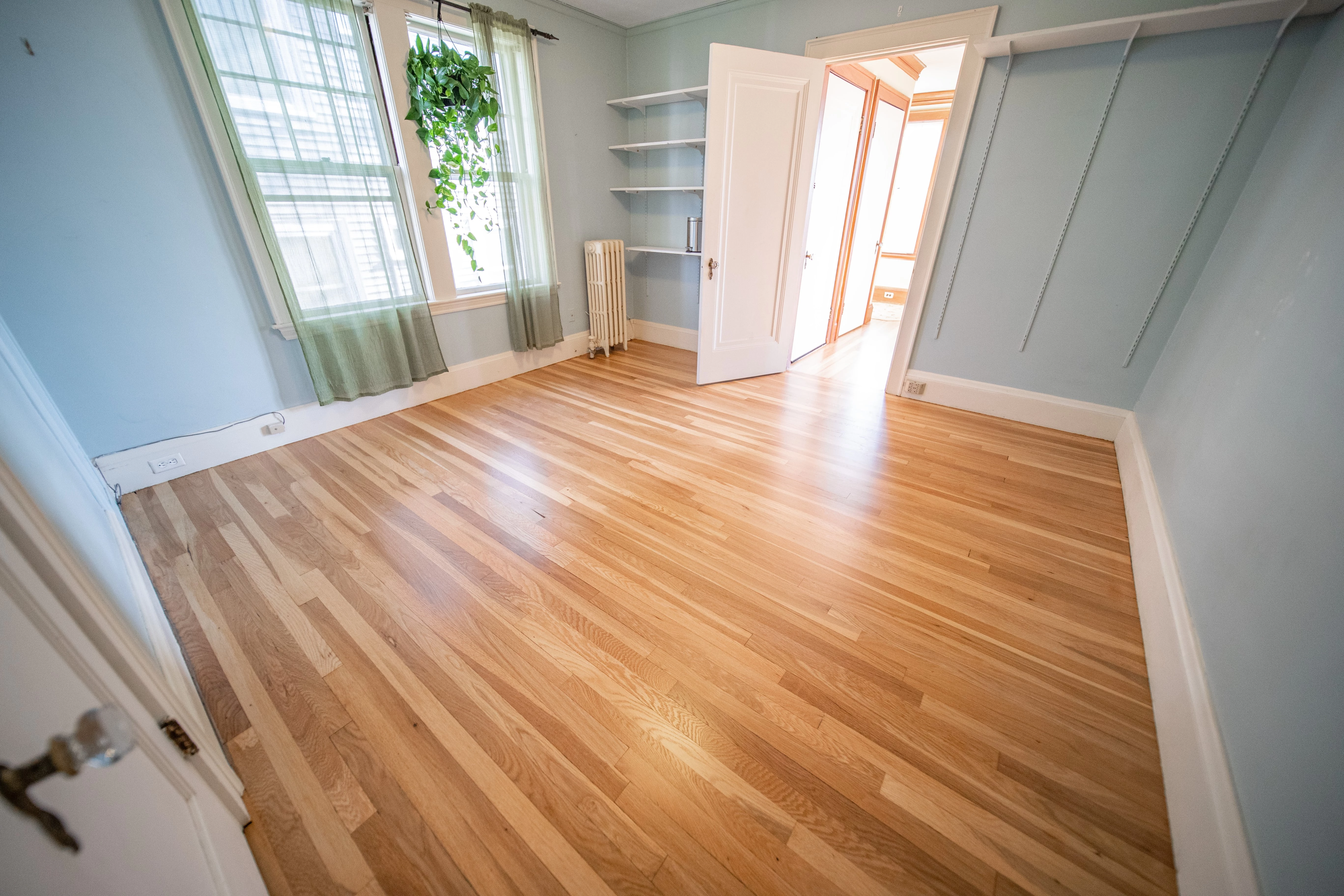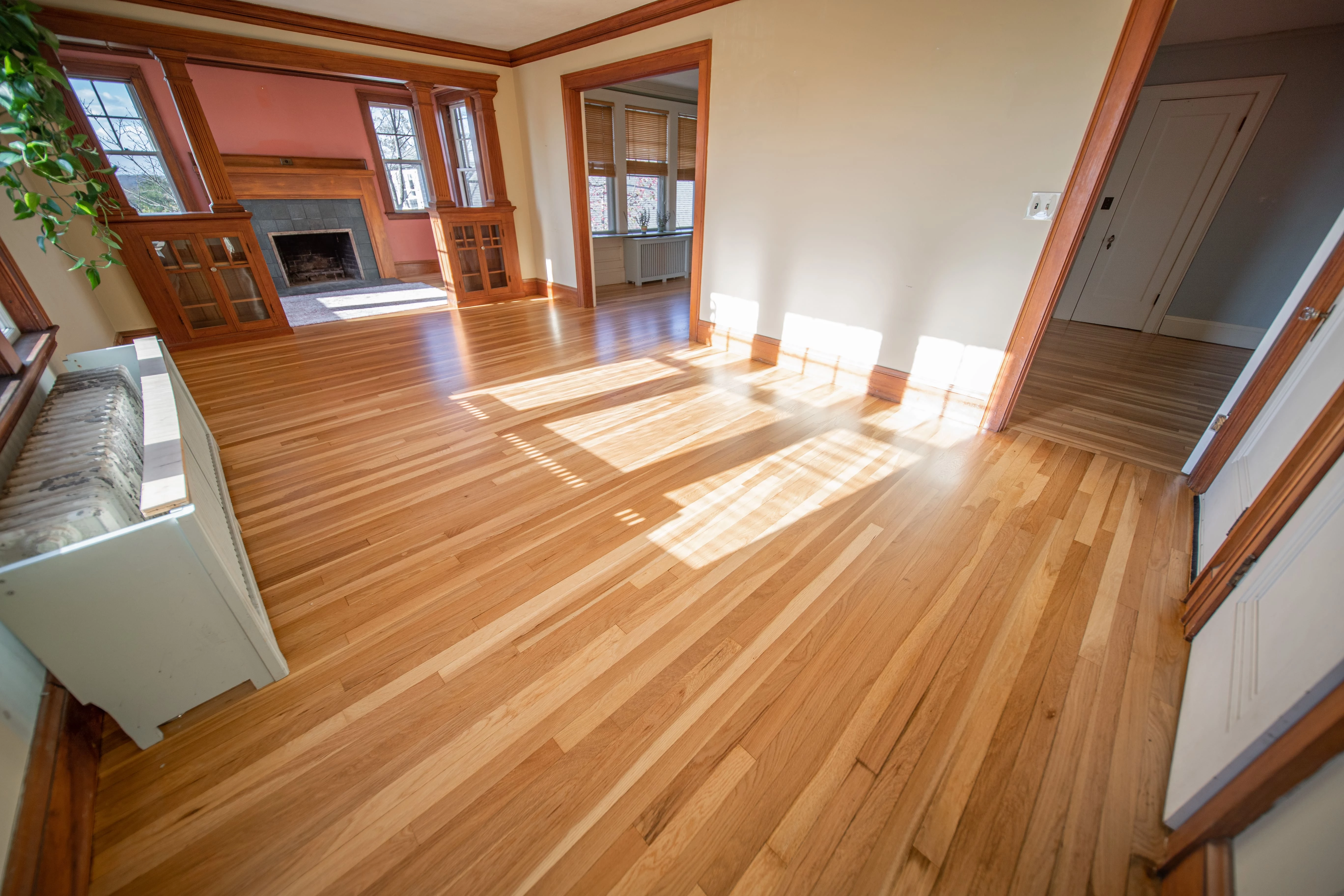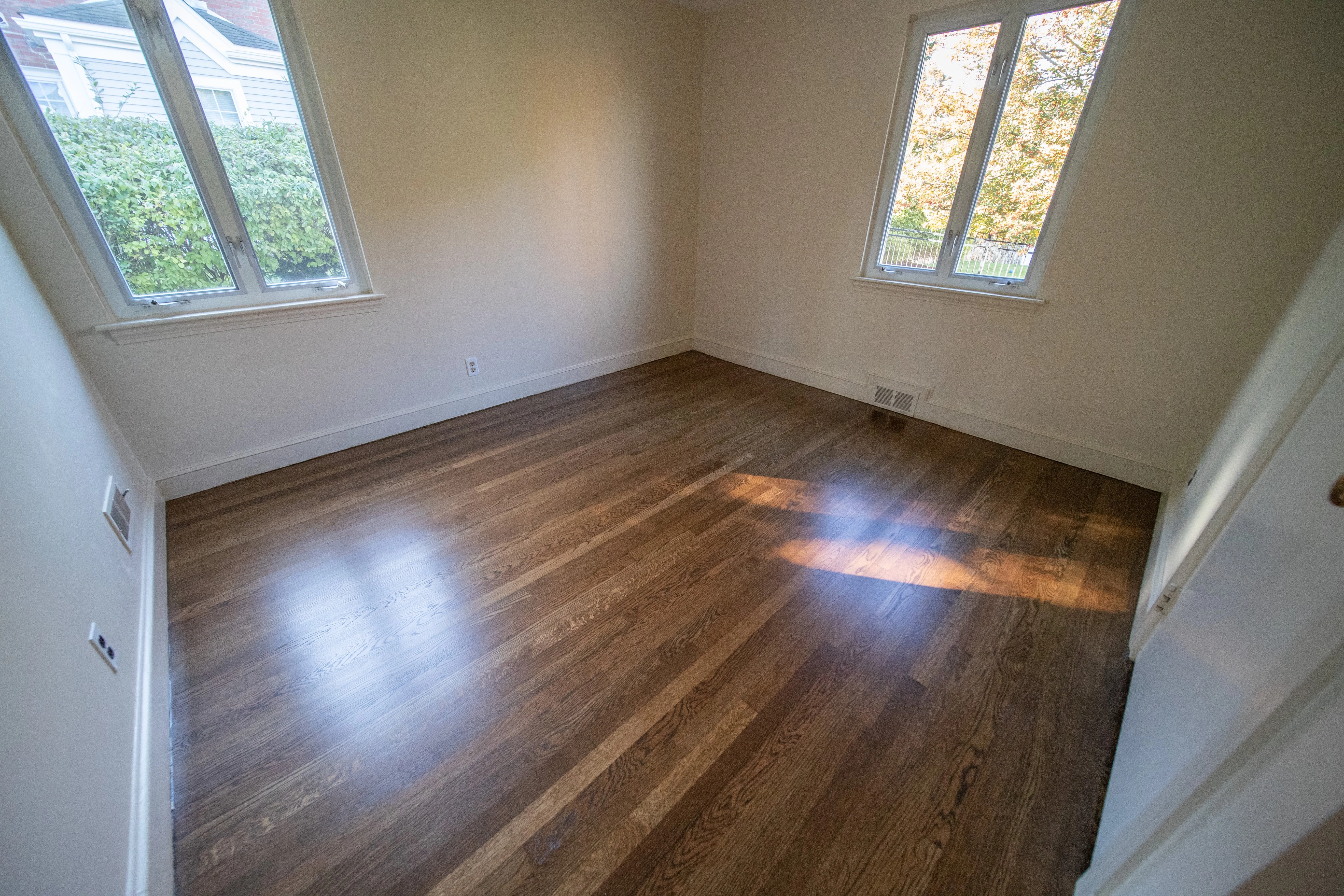- What is Wood Floor Buckling?
- Are Buckled Floors Repairable?
- Understanding Wood Floor Buckling Causes
- Excessive moisture
- Improper installation
- Other factors
- Early Warning Signs
- Gaps and plank separation
- Cupping
- Crowning
- Floorboard lifting
- Other signals
- Prevention Strategies
- Choose durable materials
- Ensuring support
- Design optimization
- Hardwood Floor Buckling Repair Guide
- Tools You'll Need
- Cost Considerations
- Step-by-Step Instruction
- DIY vs Professional Assessment for Repair
- When to Call a Professional
- Hire Floors Are Us for Wood Floors Restoration
The primary reasons behind hardwood floor buckling are excessive moisture exposure and improper installation. Leaks, spills, and high humidity can affect wood flooring, causing it to swell and lift. Poor installation makes the situation worse—as the planks expand and contract under the influence of humidity changes, they will start to buckle due to insufficient expansion gaps. Keep reading the article to find out more about hardwood floor buckling and the most efficient ways to fix your flooring.
What is Wood Floor Buckling?
Wooden floor buckling is a common type of hardwood flooring damage. Floorboards start to swell and get disconnected from the subfloor, creating an uneven surface with bumps and waves. Usually, temperature and humidity level fluctuations are the most common causes of hardwood floors buckling. Sometimes, these deformations can be left unseen, making them a tripping hazard.

Are Buckled Floors Repairable?
The short answer is yes. Many homeowners wonder how to repair buckled hardwood floors without harming the surfaces. To fix the damage, you’ll first have to define the extent of buckling. Minor buckling can be fixed even with some DIY methods, e.g., drying the area, flattening boards with weights, or replacing the damaged plank. However, severe buckling will require professional examination and repair practices.
Understanding Wood Floor Buckling Causes
There’s no single answer to what causes hardwood floors to buckle, as it’s always a multi-component phenomenon.
Check out the most widespread factors that result in buckling:
Excessive moisture
Moisture damage is the number one enemy of your wood flooring. Any type of water leaks, including plumbing spills, refrigerator drips, or spilled water, puts your hardwood flooring at risk of swelling and buckling. Apart from direct water impact, high humidity and subfloor moisture can also cause buckling.
Improper installation
If your hardwood floor is installed with insufficient expansion gaps, the wood won’t have enough space to contract and expand. Even without such complicating factors as humidity and temperature fluctuations, wood naturally expands over time. Due to having too little space, the hardwood will inevitably start to buckle. Wood acclimation issues are another cause of buckling. Before installation, floorboards need to adjust to the temperature and humidity in your home. Besides, installing wood planks over a wet subfloor can also result in buckling.
Other factors
Sometimes, it’s hard to determine the exact reason behind buckling. It may be provoked by an uneven subfloor, which creates pressure points, causing buckling. Cumulative expansion may also be the case. It occurs when wood is exposed to excessive humidity for too long. This causes buckling within the structure of the hardwood.
Early Warning Signs
After reviewing the most common hardwood floor buckling causes, let’s take a look at the first warning signs that might help you detect hardwood deterioration early.
Check whether your existing floor has some of these signs:

Gaps and plank separation
As wood absorbs liquid, it naturally expands. This caused floorboards to push against one another, creating visible gaps. These can vary in length and width depending on the amount of moisture exposure.
Cupping
Cupping is one of the buckling signs, occurring when the edges of hardwood boards bend upwards. Usually, cupping is caused by a moisture imbalance.
Crowning
Excessive humidity level leads to another sign of wood buckling. Crowning is a phenomenon characterized by the rising center of a board.
Floorboard lifting
Lifting boards is an obvious sign of buckling. If you’ve noticed planks separating from the subfloor, don’t hesitate to contact a flooring contractor in your area and ask for a professional assessment of the damage.
Other signals
Among some of the less usual signs are fading color, musty smell, and unusual noises while walking on the floor.
Prevention Strategies
To prevent hardwood floor water damage buckling or any other type of buckling, you’ll have to take diligent care of your flooring from day one. Below, the Floors Are Us team collected our tried and tested practices that will help you prevent hardwood flooring from buckling:
Choose durable materials
Consult with flooring experts on the most suitable hardwood options, considering the temperature and humidity levels in your room.
Ensuring support
You can use a support system for your flooring, like bracing, to prevent buckling. Bracing will ensure higher stability for your flooring, decreasing the chances of buckling.
Design optimization
While installing hardwood flooring, make sure your flooring experts can offer flooring design optimization options. For example, using I-beams or hollow sections helps prevent buckling and other structural damage.
Hardwood Floor Buckling Repair Guide
Your hardwood floor got wet and buckled? Below, the hardwood flooring experts from Floors Are Us collected the tools, cost considerations, and step-by-step instructions to help you fix buckled wood.
Tools You'll Need
You’ll need tools for removing buckled hardwood floorboards, preparing the subfloor, and installing replacement planks. These include a hammer, saw, and floor scraper, as well as replacement tools like a drill, measuring tape, and tools for adhesive/nails.
Removal and preparation tools:
Pry bar
With this tool, you can lift and remove buckled hardwood floors.
Claw hammer
Utilize a claw hammer to pull out nails and disconnect floor planks from the subfloor.
Chisel
This tool will help you remove planks carefully and form clean edges for replacement.
Circular saw
If necessary, you can use this tool to cut planks and remove them easily.
Scarper
You can remove old adhesive from the subfloor with a scraper.
Vacuum cleaner
Use a vacuum cleaner to remove dust and debris after floorboard removal.
Fan
Dry the area with an electric fan after cleaning.
Tools and materials for installing new floorboards:
Replacement floorboards
Make sure the replacement planks match the rest of the flooring. In case it doesn’t, be prepared to stain new boards.
Measuring tape
Measure the new planks accurately and cut them accordingly.
Drill
Before nailing new floorboards to the subfloor, you’ll need to drill starter holes.
Circular saw
Cut new planks to the correct size using a circular saw.
Nail gun
Connect replacement planks to the subfloor using a nail gun.
Flooring glue
If you use the glue-down method, apply a flooring glue or adhesive.
Weights for pressure
Apply pressure over the new boards to ensure even drying.
Power sander
Will help you smooth out the surface after installation of replacement planks.
Stain and finish
Use if the newly installed boards don’t match the rest of the flooring.

Cost Considerations
When thinking about how to fix buckled wood floors, cost is another crucial consideration that may affect your choices. The cost for repairing buckled flooring can vary depending on the extent and type of damage. Among other factors affecting the cost of buckled floor repair are the type of wood and the type of repair.
For example, minor cupping repair will only require some moisture correction and refinishing, costing around $5 to $8 per sq ft. The price for moderate cupping will range from $8 and $12 per sq ft, while severe cupping will cost you from $12 to $15 per sq ft.
In general, refinishing will cost you less than replacing wood flooring. The final price for the replacement of hardwood planks varies depending on the size of your space. On average, it will range between $2K and $10K.
Step-by-Step Instruction
To fix a buckled wood floor, you’ll have to address the underlying reasons for the damage. After you define the cause of buckling, you can choose the most efficient approach to repairing your hardwood.
Follow the steps below to repair your hardwood floor:
Identify the buckling cause
First, check the entire floor surface for water leaks, excessive humidity, or any other liquid damage. If there are no signs of moisture damage on the surface, examine the subfloor level and make sure it isn’t damaged.
Fixing minor buckling
Wipe water and disinfect the area with a hardwood-friendly cleaner. You can also use an electric fan or dehumidifier. For minor buckling, place weighty objects, e.g., boxes or books, on the affected area to flatten it.
Fixing severe buckling
If your floorboards are severely buckled, you may need to replace damaged planks. Before installing the new boards, make sure the replacement planks are acclimated to the room’s temperature and humidity. In case buckling isn’t severe, you can try to repair damage by sanding down the raised areas and refinishing the flooring.
DIY vs Professional Assessment for Repair
When you suspect hardwood buckling, the best way to identify the type and extent of wood damage is by contacting hardwood flooring contractors. DIY buckling repair can still be efficient in case of minor buckling.
Check out a comparison of the DIY vs. the professional approach to buckling repair:
Feature | DIY repair | Professional repair |
Cost | Lower upfront price, may be costly in the long run, considering high probability of a mistake | Higher upfront price, lower chances of refinement needed |
Quality | Lower quality due to lack of skills | Higher quality, professional tools and approaches |
Complexity | Only suitable for minor cosmetic repairs | Can manage damage of any severity |
Risks | High risks of mistakes and safety hazards | Minimal safety and damage risks |
Warranty | No warranty | Your project is managed and certified by professionals |

When to Call a Professional
Still googling "why is my hardwood floor buckling?” and hesitating about whether it’s time to call professionals? Read a short checklist below and learn whether your hardwood needs professional care:
Excessive moisture and humidity
If you’ve been noticing excessive humidity or moisture damage on your flooring, call professionals.
Visible buckling
Some floorboards are warped, lifted, or separated from the subfloor? These are clear red flags indicating you should call flooring experts immediately.
Subfloor damage
When the above signs are accompanied by subfloor damage, don’t wait for it to get worse—contact a trusted flooring contractor in your area today.
Hire Floors Are Us for Wood Floors Restoration
Floors Are Us is a reliable hardwood flooring contractor in the greater Boston area. With years of relevant experience, our experts will help you define the exact causes behind buckling and provide you with the most viable solutions for your specific project.
Simply drop us a line or call us at (857) 275-1766, and our flooring professionals will come back to you shortly with detailed costs and time estimates.
